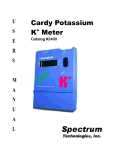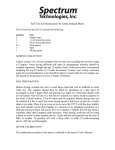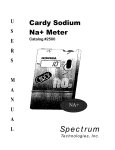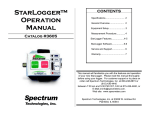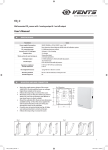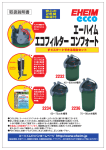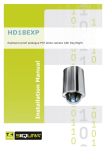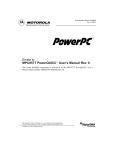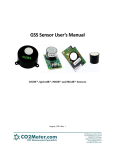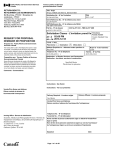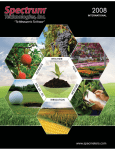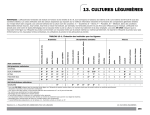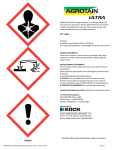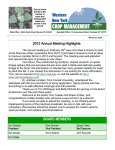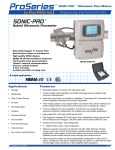Download Cardy Nitrate NO3 - Spectrum Technologies
Transcript
U S E CARDY NITRATE NO3 METER Catalog #2300 R S M A N U A L Spectrum Technologies, Inc. CONTENTS component in chlorophyll, the pigment in plants that harnesses the sun’s energy to convert CO2 into carbohydrates and makes plants green. Tools that provide increased management of N offer significant economic benefits to plant growers of all types. In addition, applying just the right amount of nitrogen at the right time can help safeguard the environment by reducing the amount of residual soil nitrate (NO3-) available to leach into ground water Introduction …………………………….. 2 Specifications …………………………….. 3 Meter Components and Accessories …….. 3 Meter Functions……….………………….. 4 Soil Test Kit Accessories ……………….. 4 Care for Your Cardy Meter .. …………….. 5 Calibrating Solutions …………………….. 6 Calibration ……………………………….. 6 Measurement Procedure …...…………….. 7 Measurement of Soil Nitrate . …………….. 7 Measurement of Soil-less Media …. …….. 8 Measurement of Tissue Sap . …………….. 9 Measurement of Groundwater and Nutrient Solutions…………………………. 10 Sufficiency Levels ....…………………….. 11 Service and Support ……….…………….. 16 Maintenance ……………………………… 16 Warranty …………….……………………. 17 The Cardy Nitrate meter presents a completely new concept in sample measurement. This self contained digital meter delivers high quality answers to nitrate level questions in soils, plants, and water- based solutions. The replaceable flat sensor makes the measurement of small samples much more convenient. When replacement of the sensor is required, the sensor cartridge snaps in and out of the meter at a touch. This manual will familiarize you with the features and operation of your Cardy Nitrate Meter. Please read this manual thoroughly before using your meter. For customer support or to place an order call Spectrum Technologies, Inc. at (815) 436-4440 between 7:30 am and 5:30 PM CST FAX: 815-436-4460 E-Mail: [email protected]. Website: www.specmeters.com The readout of the measurement value is an LCD display. It a has a total display range of 0 - 9900 PPM. This is provided by three automatically switched ranges, the X 1 range (0-99 ppm), the X10 range 100990 ppm), and the X 100 range (1000 9900 ppm ). To get the final value you simply multiply the reading on the LCD display by the proper number, 1, 10, or 100, as indicated by the small arrow on the right side of the display window. The readout can represent either (NO3-) nitrate or nitrate-nitrogen (NO3- -N) depending on how the meter was calibrated. Spectrum Technologies, Inc. 23839 W. Andrew Rd. INTRODUCTION Congratulations on the purchase of your Cardy Nitrate (NO3-) meter. This manual describes how to use your Cardy meter and how to keep it working accurately for many years. Read it thoroughly in order to make effective use of your meter. Nitrogen is one of the most important elements required for plant growth. It is a key 2 SPECIFICATIONS Principle Ion electrode method Readout LCD digital display Guaranteed Range 10-3 to 10-1 mol/l (meters can be used beyond this range) Repeatability ±20% of indication value Ambient Temperature 41 to 95° F (5 to 35° C) Compensated Sample Temperature At ambient temperature Display Range 0 - 99 x 100 ppm (9,900 ppm) Resolution 1ppm for 0 - 99 ppm 10ppm for 10-99 x 10 ppm 100ppm for 10 - 99 x 100 ppm Power 2 - CR 2025 (lithium) user replaceable. Approximately 500 hours continuous use Weight 1.4 oz (approximately 40 g.) Calibration 2 - point calibration by STD/SLOPE controls using standard calibration solutions Accessories Sampling sheets, tweezers, pipet, seals, rinse bottle and carrying case THIS EQUIPMENT HAS BEEN TESTED AND FOUND TO COMPLY WITH THE LIMITS FOR A CLASS B COMPUTING DEVICE PURSUANT O SUBPART J OF PART 15 OF FCC RULES. METER COMPONENTS AND ACCESSORIES 3 METER FUNCTIONS 7. Battery box - contains two CR - 2025 lithium cells. A “B” shows up in the display if the batteries are low. 1. Power Switch - Turns the power ON or OFF 2. STD dial - calibrates the Cardy with Standard 8. Tweezers - Use for handling sample sheet. Use the head of the tweezers for adjusting the SLOPE volume screw. 3. SLOPE volume - Calibrates the Cardy to the SLOPE calibration solution. 9. Sampling sheet - Use for measuring samples and calibrating meter. Assures that the solution bridges across the sensor pad properly. NO3-. 4. LCD display - Expressed as ppm Displayed by one of three automatically switched ranges. X1 (0 - 99 ppm) X 10 (100 - 990 ppm) X 100 (1000 - 9900 ppm) 10. Pipette - Use for depositing solutions on the sensor for measurement. 11. Standard Solutions - Use for calibrating the meter. 5. Sensor pad - Ion-specific electrode principle: replaceable. 12 Yellow Seal - Use to cover the sensor (reference junction) when meter is idle for more than 30 days. The reference junction is positioned on the right side of the sensor pad. 6. Sensor cover - protects the sensor during storage. SOIL TEST KIT ACCESSORIES Description #2329S* Starter Kit #2329 Replenishment Kit Std. Solution 450ppm NO3--N (30ml) 1 1 Extractant 20ppm NO3--N (1 Liter) 1 2 Cups - 8oz. 3 3 Measuring Spoon (29.5 cc) 1 1 Pipet 1 1 Filter Papers 15 *Included with meter in item #2300 Handheld Plant Sap Press (item #2725) Hydraulic Plant Sap Press (item #2720) 4 30 CARE FOR YOUR CARDY METER 1. If the sensor is new or has been inactive for over a month, drip 3 to 4 drops of either one of the standardizing solutions onto the sensor pad using a sampling sheet to “warm-up” the sensor for 20 to 30 minutes. The meter can be off. This improves sensor response time and reduces the drift of the readings. 2. A stable meter reading occurs when the value on the LCD display has not changed for a period of three (3) seconds. 3. Wait 30 to 45 seconds after the solution has been placed on the sensor pad when calibrating or making a reading. A functional sensor should reach a “stable” reading during that time. 4. When measuring a sample, make sure that the sample is covering the two black round sensors in the sensor pad. The ion concentration cannot be measured if the electrodes are not covered by the sample. 5. Use clean tweezers to handle the sampling sheet. 6. In order to obtain measurement values of high repeatability, maintain identical conditions as much as possible. 7. It is normal to see some liquid on a spot of the small electrode. Simply rinse and blot the electrode dry. 8. Any kind of soft wiping tissue or paper towel may be 5 used to blot the sensor dry after rinsing. CALIBRATING SOLUTIONS NO3- nitrate versus nitrogen NO3--N CALIBRATION Important: The user must be consistent in calibrating the meter to either NO3– or NO3--N on both standards. nitrate- The sensor of the Cardy meter measures NO3- nitrate ion activity similar to the way a pH sensor measures H+ ion activity. Decide whether you desire the meter LCD display to express the sample concentration as NO3- nitrate or NO3--N nitrate-nitrogen. (Note: this is similar to reflecting length as 6 in. or ½ ft.). Laboratory analysis and university guidelines are generally expressed as NO3--N nitrate-nitrogen. 1. Turn the power ON. 2. Open the sensor cover, rinse the sensor pad with distilled water and blot the sensor pad clean with a piece of sampling sheet or tissue. Repeat rinsing and blot dry. 3. Place a piece of sampling sheet onto the sensor pad and drip 3 to 5 drops of the standard STD solution on it (or drip the solution directly onto the sensor pad). Be sure both dots (A&B as shown on pg 7) on the sensor pad are covered and there is a continuous bridge between them. To convert NO3--N nitrate-nitrogen to NO3– nitrate: multiply or divide NO3--N x 4.42 = NO3– NO3--N / .226 = NO3– 4. After the readout has stabilized (30 - 45 sec), adjust the STD dial until the display reads the value on the bottle (i.e. 45 x 10). Be mindful of the whether you are calibrating to units of NO3– or NO3-N. Therefore: 2000 ppm NO3– nitrate = 450 ppm NO3--N nitrate-nitrogen 88 ppm NO3– nitrate = 20 ppm NO3--N nitrate-nitrogen The following table shows the concentrations of the various calibration standards in each unit of measurement. Description Type ppm NO3– ppm NO3--N #2338 450 ppm NO3--N * STD 2000 450 #2339 20 ppm NO3--N * SLOPE 88 20 #2336 450 ppm NO3--N ** STD 2000 450 5. After cleaning the sensor according to step 2, apply the SLOPE solution as in step 3. After the readout has stabilized, pull the rubber plug and use the driver end of the tweezers to adjust the SLOPE until the display reads value on the bottle (i.e. 20 x 1). Again, be mindful of the units. *#2335L For 20 use with sap, water ppm NO3-plant -N ** SLOPE 88and nutri20 ent solutions ** For use with soil samples 6. Rinse the sensor and blot dry as in step 2. Repeat and blot dry. Note: If the meter is new or has not been used recently, repeat the calibration with both standards. 6 MEASUREMENT OF SOIL NITRATE 7. The meter’s calibration can be checked when desired. Drip 3 to 5 drops of either calibration solution onto the sensor pad making sure both electrode dots are covered. Recalibrate if the display does not read ± 10% of the desired value. Sample Collection Collect at least 15 to 20 core samples from an area not exceeding ten acres by using a Z pattern. Areas having different soil types or management histories should be sampled separately. Sample the top 12 inches of soil. Some universities recommend sampling the top 24 inches in 12 inch increments. Contact your county extension agent for recommendations. Care should be taken to ensure that soil samples are not biased by the presence of rows or bands of fertilizer. 8. Replace the slope adjusting plug. MEASUREMENT PROCEDURE 1. Measurement can be aided by placing the sample onto a piece of sampling sheet. Using the pipette included in the case, transfer 3 to 5 drops of the pressed plant liquid onto the sensor pad. A sampling paper may also be placed on the sensor and saturated with the liquid. Note: the plant sap press may be ordered from Spectrum Technologies, Inc., or your distributor. 2. After the value has stabilized (30 to 45 seconds), read the results from the display. Sample Preparation Samples should be dried within 24 hours of collection to minimize changes in NO3--N concentrations. Before drying, crumble the soil to avoid large clods that will be difficult to crush when dry. The samples should then be dried by spreading on a thin layer of newspaper at least 3 pages thick and placing overnight in a warm spot with good air movement. Soil will dry in a few hours if placed in a sunny location exposed to the wind. If dried indoors, 24 to 48 hours may be required. Indoor drying time can be reduced with the use of a fan. For oven drying, spread a thin layer of soil on a cookie sheet or pie plate. Place it in an oven set to no more than 250oF with the door slightly ajar. Consider the soil dry when it crumbles rather than compacts under pressure. After drying, crush the soil by using a block of wood or other suitable device. Crush until the soil particles are the size of BB’s or smaller. Sift with a flour sifter or other 10 mesh screen. Mix soil thoroughly. Note that the reading may be in units of NO3- or NO3--N depending on how the meter was calibrated. 3. Rinse the sensor pad with the distilled water and blot it dry with tissue or a paper towel. Repeat rinse and blot dry. 4. Repeat the procedure from the bulk sample 2-3 times and average the result to get a representative result. Soil testing of mineral soil requires the Soil Test Kit. A starter kit is included with the Cardy NO3- meter #2300. Additional Soil Test Kits can be ordered as item #2329. Important: Do not make measurements with the meter (sensor) in direct sunlight. Important: Be sure you are using the soil standard solutions (item nos. 2335L and 7 MEASUREMENT OF SOIL-LESS MEDIA 2336) when calibrating the meter for soil tests. Do not use the calibration standards for water/plant sap (See Calibration, pg 6) Measurement Procedure: 1. Measure 2 level measuring spoons (30 ml) full of dry soil into the soil sample cup. Sample collection 1. Collect just before plants are irrigated. 2. Avoid the top layer of media with no roots. 3. Collect root media from the bottom ⅔ of the pot. 4. Take samples from 10 or more plants distributed in the sample population. 5. When a sufficient amount of root media is collected, mix the sample. 2. Add 2 (30 ml) measuring spoons of the soil extractant to the soil. 3. Mix the soil and the solution by stirring with the spoon for at least 2 minutes, making sure the soil sample is thoroughly mixed with the distilled water. Let stand for 5 minutes Sample Preparation and Analysis 1:2 Extraction method 4. Fold a circular filter in half ‘twice’ and open it up to form a cone. Place it in the soil suspension as far as possible. The filtration will take place from the outside of the filter to the inside. Measure a known volume of root media in a beaker or cup (usually 50 to 100 ml or ¼ to ½ cup). Fill firmly so it is compressed as it was in the pot. Be consistent when measuring. DO NOT lightly fill or heavily pack the beaker. Place the sample into a cup or beaker. 5. As soon as sufficient filtrate accumulates in the filter, use the small pipette to transfer the soil extract onto the sensor of the Cardy Meter. Add 2 equal volumes of distilled water into the cup, mix the sample and wait 10 minutes. Measure the nitrate after sieving out the large particles. The nitrate level can be read directly from the slurry. 6. Read the value from the digital display after it has stabilized (30 - 45 sec.). Subtract 20 from the display value. This accounts for the 20 ppm NO3- in the extractant solution. For lbs/acre, multiply by 4 for a sampling depth of 12 inches. Saturated media extract method 7. Rinse sensor and blot dry. Display should read close to “0” with distilled water on it, if not rinse again. Moisture content Sand Clay sand Sandy clay Very dry +8% +15% +17% +23% dry +12% +20% +24% +33% Med-moist +12% +25% +31% +43% moist +14% +30% +38% +53% Very moist +16% +35% +45% +63% Place 300 to 500 ml (1 to 2 cups) of root media sample in a cup or beaker. Slowly add distilled water, constantly stirring the sample with a spatula or knife. Add enough distilled water sot that the sample behaves like a paste with the surface glistening with water, but with no free water on the surface of the sample. Clay, Loess After 15 minutes, add more water if needed. Extract the solution from the media using a pipet, buchner funnel, side arm, flask and vacuum pump or, for the flat electrode meters, a filter bag or sieve. Make any additional measurements (such as EC) using the extracted solution. Table 2 gives a general idea of the nitrate levels to look for in the extracted solution. Table 1: Estimated soil nitrate percentage correction for soils at various field moisture levels. Increase the value given by Cardy meter by the percentage shown in the table. 8 Media Type ppm NO3--N in extract Seedlings 40 - 70 Young pot and foliage plants 50 - 90 Pot and bedding plants-growing on 80 - 160 Roses, mums or snapdragons in ground or raised beds 120 - 200 Lettuce and tomatoes in ground beds 125 - 225 Celery transplants 75 - 125 petioles and mix and sub-sample these pieces for testing. Crops with small, dry petioles, such as strawberries require much larger samples to get enough sap compared to fleshy crops such as tomatoes. Store whole petioles, not leaves, at room temperature for up to 1½ hours or on ice for up to eight hours. Cold petioles should be warmed to room temperature before taking a measurement. Measurement Procedure Table 2: Interpretation of Greenhouse Soils: Desirable NO3- N concentrations in saturated media extract. 1. Use a plant sap press to squeeze sap from the petioles. Use the sub-sample from step 3 of the sample collection procedure and place it in the press. Close the press and rotate so the holes face up. Center a sampling sheet over the holes. As the press is squeezed, the sap will saturate the sampling sheet. Make certain to press all the sap from the plant tissue in the press. MEASUREMENT OF TISSUE SAP Sample Collection: When conducting a test on plant materials, the biggest source of error is due to sampling. This error results when a sample is not representative of the source. Follow these steps to gather and care for your sample: Note: the plant sap press may be ordered from Spectrum Technologies, Inc., or your distributor. 2. With the tweezers, transfer the saturated sampling sheet directly onto the sensor pad. 1.) Do not sample plants which show obvious signs of nutrient deficiency or damage from disease, insects, or chemicals unless these plants are the subject of a study. Plants which have been under stress for a period of time may not give a true picture of the nutrient status of the field. 3. Wait for the reading to stabilize (30 to 45 seconds). Note that the reading may be in units of NO3- or NO3--N depending on how the meter was calibrated. 4. Rinse the sensor pad with the distilled water and blot dry. Repeat the rinse 2 to 3 times. 2.) The leaves or parts of leaves selected should be of the same age and relative position on the plant. The most recently matured leaves should be used. These are the leaves that have stopped expanding in size. The petiole or leaf stem of the leaf or appropriated plant material should be used for the test. 5. Repeat the procedure from the bulk sample 2-3 times. Average the result to get a representative result for the sample being measured. Important: Do not make measurements with the meter (sensor) in direct sunlight. 3.) A minimum of 25 petioles or leaves should be collected. This is enough to represent a five to ten acre field if the field is judged to be uniform. Chop up the 9 MEASUREMENT OF GROUNDWATER AND NUTRIENT SOLUTIONS Sample Measurement Using a pipet, transfer several drops of liquid onto a sampling sheet on the sensor pad. Make certain that the liquid covers both dots on the sensor pad. After the display has stabilized (30 - 45 sec), read the results from the meter display. For ground water, the acceptable nitrate levels are: < 45 ppm as NO3- nitrate or < 10 ppm as NO3--N nitrate nitrogen Nutrient Solutions Perform the measurement as indicated above. If the sample concentration exceeds 9900, the meter will display will read “--”. Dilute the sample with distilled water at a ratio of 1:9 (1 part sample to 9 parts water) and re-measure. Multiply the meter reading by 10 to adjust for the dilution. 10 Petiole NO3--N Sufficiency Levels For Drip-Irrigated vegetables (Source: UC-Davis) Petiole NO3--N concentration Dry Tissue Fresh Sap 10,000 - 20,000 1000 - 1600 8000 - 15,000 800 - 1200 5000 - 8000 600 - 1000 Crop Broccoli Growth Stage Mid growth Button formation Preharvest Cabbage Cupping Early heading Mid heading Canteloupe Early flower Fruit bulking First harvest Cauliflower Mid growth Curd development Preharvest Celery Mid growth Preharvest 7000 - 10,000 6000 - 10,000 600 - 800 400 - 600 Lettuce Early head formation Preharvest 7000 - 10,000 6000 - 8000 400 - 600 300 - 500 Onion Bulbs 0.5-1.5 in. Pepper Vegetative growth Early flower/fruit Fruit bulking Preharvest Potato (Russet Burbank) Early vegetative Mid tuber/bulking Late tuber/maturation Sweet Corn Entire season Tomato Vegetative growth Early flower/fruit Fruit bulking Preharvest Watermelon Early flower Fruit bulking Fruit harvest * * * 1200 - 1500 1000 - 1200 700 - 900 12,000 - 15,000 1000 - 1600 8000 - 10,000 800 - 1000 4000 - 6000 700 - 800 * * * 7000 5000 5000 5000 1000 - 1600 700 - 1000 500 - 800 * 350 - 500 - 10,000 - 8000 - 8000 - 7000 900 - 1200 700 - 1000 700 - 1000 700 - 900 17,000 - 22,000 1300 - 1600 11,000 - 15,000 900 - 1200 6000 - 8000 550 - 700 * 10,000 - 14,000 9000 - 12,000 6000 - 8000 4000 - 7000 600 - 700 700 600 500 400 - 900 800 700 600 12,000 - 15,000 1000 - 1600 8000 - 15,000 700 - 900 5000 - 8000 500 - 700 11 Petiole NO3--N Sufficiency Levels (Source: University of Florida) NO3--N (ppm) Fresh Sap Crop Growth Stage Cucumber First blossom Fruits 3-inches long First harvest 800 - 1000 600 - 800 400 - 600 Broccoli & Collards Six-leaf stage Just prior to harvest At first harvest 800 - 1000 500 - 800 300 - 500 Summer Squash First blossom First harvest 900 - 1000 800 - 900 Muskmelon First blossom Fruits 2-inches long First harvest 1000 - 1200 800 - 1000 700 - 800 Tomato (field) First buds First open flowers Fruit 1-inch diameter Fruit 2-inch diameter First harvest Second harvest 1000 600 400 400 300 200 - 1200 - 800 - 600 - 600 - 400 - 400 Bell Pepper First flower buds First open flowers Fruits half-growth First harvest Second harvest 1400 1400 1200 800 500 - Eggplant First fruit (2-inches long) First harvest Mid harvest 1200 - 1600 1000 - 1200 800 - 1000 Potatoes Plants 8-inch tall First open flowers 50% of flowers open 100% of flowers open 1200 1000 1000 900 - 1600 1600 1400 1000 800 1400 1400 1200 1200 NO3--N (ppm) Fresh Sap Crop Growth Stage Annual Hill Strawberries (October planting) November December January February March April Watermelon Vines 6-inches long Fruit 2-inches long Fruits half mature First harvest 800 600 600 300 200 200 12 1200 1000 800 600 - 900 800 800 500 500 500 - 1500 - 1200 - 1000 - 800 Optimum range of nitrate-nitrogen concentrations (dry weight and sap Petiole NO3--N Sufficiency Levels For Potatoes (Source: Univ. Wiisconsin-Madison) Growth Stage Norkotah, (days after Norland, emergence) Atlantic, Kennebec Shepody, R. Burbank, Snowden Onaway Superior Dry Weight Basis (% NO3--N) dae 30 2.5 - 2.8 2.0 - 2.3 2.3 - 2.5 40 2.3 - 2.5 1.7 - 2.2 2.0 - 2.3 50 1.8 - 2.3 1.2 - 1.6 1.5 - 1.9 60 1.3 - 1.9 0.8 - 1.1 0.9 - 1.2 70 0.8 - 1.1 0.5 - 0.8 0.4 - 0.6 - Sap Basis (ppm NO3 -N) 30 1900 - 2100 1600 - 1800 1800 - 1900 40 1800 - 2000 1600 - 1700 1600 - 1800 50 1400 - 1800 1000 - 1300 1200 - 1500 60 1110 - 1500 700 - 900 500 - 1000 70 700 - 900 500 - 700 400 - 600 Values from the Cardy can be converted to dry tissue calibration by using the equation: %Dry Weight NO3--N = 0.00142 (ppm sap NO3--N) - 0.21 Petiole NO3--N Sufficiency Levels Russet Burbank Potatoes (Source: Univ. of Minnesota) Petiole NO3--N (ppm) Growth Stage Dry Tissue Fresh Sap Early Vegetative/tuberization 17,000 - 22,000 1300 - 1600 Mid tuber growth/bulking 11,000 - 15,000 900 - 1600 Late tuber growth/maturation 6,000 - 8,000 550 - 700 13 Petiole NO3--N Sufficiency Levels (Source: Michigan State University) The following guidelines are based on one year’s research results and will be revised as necessary based on future research findings. Readings taken on youngest fully extended petiole. Carrots Adequate petiole sap nitrate concentration Carrot shoulder diameter (in.) Nitrate-N (ppm) Nitrate (ppm) Prior to sizing 750+ 3,300+ 0.00 - 0.25 550+ 2,420+ 0.25 - 0.50 450+ 1,980+ 0.50 - 0.75 300+ 1,320+ 0.75 - 1.50 250+ 1,100+ > 1.50 200+ 880+ Celery Adequate petiole sap nitrate concentration Weeks after transplant Nitrate-N (ppm) Nitrate (ppm) 0-5 800+ 3,520+ 5-6 725+ 3,190+ 6-7 650+ 2,860+ 7-8 575+ 2,530+ 8-9 500+ 2,200+ 9 - 10 425+ 1,870+ 10 - 11 350+ 1,540+ 11+ 275+ 1,210+ Onions Adequate petiole sap nitrate concentration Growth Stage Nitrate-N (ppm) Nitrate (ppm) Up to 5 leaves 800+ 2,520+ 5 to leaves 600+ 2,640+ Bulb initiation 300+ 1,320+ Bulb bulking 250+ 1,110+ 14 Pre-Sidedress Nitrate (PSNT) Soil Test Interpretation University of Tennessee ppm NO3--N Low ppm NO3--N Low ppm NO3--N Low <17 17 - 25 >25 Rutgers Cooperative Extension PSNT Soil Test Level (ppm NO3--N) Sidedress N Recommendation 1 - 15 16 - 20 21 - 25 26 - 30 31+ 160 120 80 40 0 University of Wisconsin Soil Potential* Very High/High Medium/Low PSNT result (ppm N) N/application Rate (lbs/Acre) <10 160 120 11 - 12 150 80 13 - 14 125 80 15 - 17 100 40 18 - 20 60 40 >21 0 0 * consult WMEX pub. A2809 Pennsylvania Nitrogen Soil Test Recommendation (Lbs N/Acre) (Source: Penn State University) Corn Yield Goal Soil Test Level (ppm NO3--N) 0 - 10 11 - 15 16 - 20 21 - 25 25+ 100 100 75 50 25 0 125 130 100 75 50 0 150 160 125 100 75 0 175 190 150 125 100 0 200 220 150 125 100 0 Note: Check you county extension office for updates 15 SERVICE AND SUPPORT adjustment in the slope screw) or b) the meter drifts from its calibration standards when rechecking the two (2) point calibration. Repeat the calibration and check for drift. For technical service and support, call your distributor or Spectrum Technologies, Inc. at (815)436-4440. Samples likely to damage the sensor pad include organic solvents, surface activators, cement, alcohol, strong acid, strong alkali, etc. The sensor pad is a thin, soft film. Do not handle in such a way that will scratch or damage the sensor. When calling for technical support have a detailed explanation of the problem that you are experiencing. The more information you can provide, the faster and easier a technical support person will be able to assist you. If samples have a small amount of oil, it may be necessary to clean the sensor with a mild detergent solution. MAINTENANCE Battery: To replace the sensor, turn the meter over and take the sensor off both hooks with the tweezers or a similar tool. Attach the new sensor to the meter properly until it makes a clear click sound. When the meter LCD display shows the battery symbol “B”, batteries need replacing. To replace batteries, turn the meter over and remove the circular battery cover. Release the cover by placing a coin in the slot and turning it in the direction shown to open. Place new batteries (CR2025) with the positive terminal up and under the metal tab. Replace the battery cover. Replace both batteries at the same time. Do not throw old batteries into a fire. Do not leave old batteries in reach of children. If a child does accidentally swallow a battery cell, call a doctor immediately. Sensor: The field replaceable sensor has a life of approximately 150 - 300 measurements depending on the sensor age, frequency of use and maintenance. The sensor is worn out when a) the sensor will not calibrate to the “slope” standard (there is no more 16 WARRANTY Our obligation under this warranty is to repair or replace the CARDY free of charge in accordance with the conditions laid down herein. Accordingly, this warranty does not limit your specific legal rights. The warranty card must be completed and mailed promptly in order to register your CARDY under our warranty. This product has been brought to you having passed severe quality control and inspections. Should any trouble occur during the course of normal use, the CARDY shall be repaired or replaced free of charge in accordance with the stipulations laid down herein. The term of this warranty shall be for three months from date of purchase. This warranty excludes batteries, sensor and accessories. Product Return If for any reason you are not satisfied, or the meter has failed and you need to return the product for service, you will need to contact Spectrum Technologies, Inc. Warranty Stipulations: 1. The product shall be repaired or replaced free of charge should any trouble occur during the course of normal use if returned within the warranty period (three months from date of purchase). In which event, contact the dealer of purchase. Return CARDY with proof of date of purchase. Before returning a failed unit, you must obtain a Returned Goods Authorization (RGA) number from Spectrum. You must ship the product(s), properly packaged against further damage, back to Spectrum (at your expense) with the RGA number marked clearly on the outside of the package. Spectrum is not responsible for any package that is returned without a valid RGA number or for the loss of the package by any shipping company. 2. Expenses shall be incurred in the following instances within the warranty period. (Costs such as postage shall be borne by the customer) a.) When the date of purchase and store name is not written on the warranty. b.) When trouble or damage has been incurred due to misuse, abuse, and/or improper handling. c.) When the CARDY has been repaired, modified and dismantled by persons other than a HORIBA designated agent or service shop. d.) In the event of changes in external appearance (such as scratches or dirt caused during use) or battery fluid leakage. e.) In the event of unsuitable movement, dropping or accidents such as fire, earthquake, floods or burglary. f.) When replacing consumables and accessories. g.) When cause of trouble lies not in the CARDY itself. h.) When this warranty is not shown and when necessary particulars have not been written in the warranty. Spectrum Technologies, Inc. 23839 W. Andrew Rd Plainfield IL 60544 (800) 248-8873 or (815) 436-4440 Fax (815) 436-4460 E-Mail [email protected] Website: www.specmeters.com 17

















